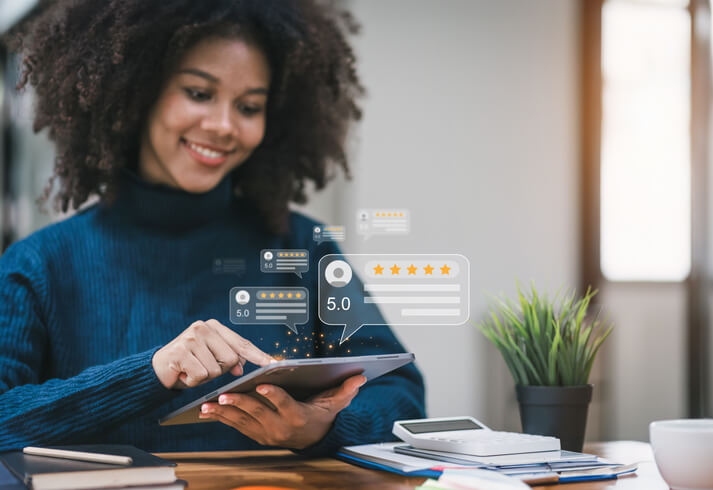Nearly two-thirds (64%) of American adults now own a smartphone and a large percentage of those adults (46%) agreed with the statement “I can’t imagine my life without my smartphone.” (Gallup poll)

Americans spend an average of 4.7 hours a day on their smart phones checking email, socializing, working, browsing, shopping, watching movies, playing games, and on apps. According to a survey released by AT&T and the Center for Internet and Technology Addiction, 61% of Americans sleep with their phones and 53% get upset if they are without their phones.
Interesting fact -there is an actual term for fear of being without a mobile phone called Nomophobia. Nomophobia is referred to a psychological syndrome in which a person is afraid of being out of mobile or cell phone contact. According to Techopedia, “Nomophobia, coined from a term ‘no-mobile-phone-phobia’ during a research study to find out the psychological ramifications and stress level of mobile phone usage on behavior, describes the level of fear generated when a user is unable to communicate through their cell phone.”
Approximately 8 in 10 device owners keep their smartphone near them almost all the time during waking hours, with 52% of US smartphone owners saying they check their phone a few times an hour (41%) or every few minutes (11%).

Retailers are taking this mobile lifestyle to heart and responding with mobile technologies, apps, and experiences to appeal to today’s shoppers. The number one way they are doing so is through mobile coupons. According to research by PointSource, “Almost 60% of US retail marketing and IT professionals surveyed said their company used mobile coupons, the highest of any mobile tactic or technology. Another 51% offered mobile payments, and 40% said their company had a loyalty app.”

Despite the flurry of new mobile offerings, retailers continue to struggle with integrating mobile into the overall marketing strategy. According to the research, 44% of respondents stated integrating mobile was the biggest challenge. Other challenges to mobile marketing included uniting marketing and IT teams (42%), lack of internal sources (24%), and not enough budget (20%).

56% of Retail Searches Come From Mobile
According to recent research conducted by Connexity, 56% of visitors to the Hitwise Retail 500, a collection of the top 500 retail websites now come from smartphones or tablets. Some of the top search themes include:
- 82% – Reviews
- 82% – terms such as “24-hour”, “near me”, “hours”
- 89% – Layaway
- 77% – Coupon
- 77% – Return Policy
With so many searches focused on coupons, this further validates the importance of mobile coupons. In addition to the 77% of searches focused on the word “coupon”, an additional 73% of searches are for “sale” and 68% for “discount”.
Mobile Payments Are on the Rise
This year was a significant year of growth for mobile technology. According to a forecast from eMarketer, the total value of mobile payment transactions in the US was to grow by 210% in 2016. According to the research, “In 2015, mobile payments will total $8.71 billion in the US, with users spending an average of nearly $376 annually using their mobile phone as a payment method. By 2016, total mobile payment transactions will reach $27.05 billion, with users spending an average of $721.47 annually. Total mobile payment sales will rise faster than average spending per user in 2016 because of the growth in the number of overall users of the technology.”

More than a quarter of US smartphone owners use mobile payment apps at least monthly, according to a report from Parks Associates, and more than 3 million retailers now accept Apple Pay, Android Pay or both.
Location-Based Mobile Messaging
Beacon technology allows brands to pinpoint where a customer is at any given moment, and then send them push notifications with coupons, promotions or other targeted offers. The use of beacons is further transforming the shift to mobile commerce by providing immediate relevancy and value to customers. For example, a clothing retailer store may send a promotion to a consumer near their location or while the individual is visiting a competitor.

A study conducted by beacon platform Swirl found that 73% of shoppers who received a beacon-triggered message on their smartphone said it increased their likelihood of making a purchase during a store visit, while 61 percent said the message would prompt them to visit the store more often.
Integrating Mobile into the Omnichannel Experience
With consumers using their smart devices throughout their shopping journey, retailers can capitalize on new opportunities to integrate mobile into the entire omnichannel experience. Consumers don’t think about offline, online, or mobile – they are simply shopping.

Research by GfK on behalf of Facebook IQ studied the habits of more than 2,400 “omnichannel shoppers.” These are consumers who researched and bought online through a variety of channels including mobile devices, tablets, desktops or laptops and in-store.
According to the study findings:
- 45% of all shopping journeys today involve mobile, with that figure climbing to 57% for millennials
- 56% of respondents said they made purchases on mobile devices because they were already using those devices
- 55% did so because they can do it anywhere and anytime
- 60%t said they will begin purchasing more on their smartphones in 2016 or purchase more, and 64% said they will use those devices for more shopping research
- 61% said they expect to use their smartphones more while they are in physical stores
- 46% of respondents who researched product ratings or reviews prior to offline purchases did so via mobile devices, while 36% used those devices to compare prices and 51% researched products while in-store
What reasons motivated respondents who preferred to purchase in-store or via desktop or laptop? According to GfK:
- 56% find it easier to see all available products
- 55% find it easier to use devices with larger screens
- 27% find it difficult to compare products or retailers via smartphones or tablets
- 26% find it difficult to enter personal data on smartphones or tablets
- 70% of mobile shoppers say the overall website and application experience can be improved, while 71% said the same for the transaction experience
With mobile being so pervasive throughout the shopping journey, retailers must create a seamless experience as shoppers move from device to device. 54% of omni-channel shoppers say they are more likely to shop with a retailer that makes it easy to buy on several devices. Integrating mobile capabilities into the overall marketing strategy ensures a smooth transition for consumers as they shop both offline and online.
Learn how Porch Group Media can help you get to know your customers better and reach them across channels to boost your marketing success. Contact us to get started!





